| Author |
Message |
M. Eversberg II

|
 Posted: Sun 28 Jan, 2007 7:35 pm Post subject: I.33 Weapon Question Posted: Sun 28 Jan, 2007 7:35 pm Post subject: I.33 Weapon Question |
 |
|
I am considering teaching myself I.33 fencing seince I've interest in the time period it was written in. I have generated the following questions:
1) What weapon are they using? As in, the Oakeshot Type? My guess is they where simple arming swords (Type XI?).
2) If I where a period man-at-arms, would I be using these techniques on the battlefield? Would I be using the buckler, or would I stick to the heater shield? (Heater in this case being as I know it, the typical Rounded V with a stright top, curved against your body)
3) Where there manuals for heater/arming sword?
4) What would be a good waster for practice? I guess any one handed one would do, and you all have reccomended Little Raven (If I recall correctly) as the best source for these.
M.
|
|
      |
 |
Chad Arnow
myArmoury Team


|
 Posted: Sun 28 Jan, 2007 8:14 pm Post subject: Posted: Sun 28 Jan, 2007 8:14 pm Post subject: |
 |
|
I think that Types XII and XIV are most like the I.33 swords. Some taper, and a decent point.

ChadA
http://chadarnow.com/
|
|
    |
 |
Dan Dickinson
Industry Professional

|
 Posted: Sun 28 Jan, 2007 8:15 pm Post subject: Posted: Sun 28 Jan, 2007 8:15 pm Post subject: |
 |
|
Well, I'm afraid that I can't answer the other questions right now, but as to question #1, I believe that instead of type XI, since most swords appear to be depicted as fairly short, quickly tapering and having a good point, you'd be better off with a type XIV.
Hope this helps,
Dan
|
|
  |
 |
Dan Dickinson
Industry Professional

|
 Posted: Sun 28 Jan, 2007 8:16 pm Post subject: Posted: Sun 28 Jan, 2007 8:16 pm Post subject: |
 |
|
Woops, looks like Chad got there first,
Dan
|
|
  |
 |
|
Hugh Knight
|
 Posted: Sun 28 Jan, 2007 8:21 pm Post subject: Re: I.33 Weapon Question Posted: Sun 28 Jan, 2007 8:21 pm Post subject: Re: I.33 Weapon Question |
 |
|
| M. Eversberg II wrote: | I am considering teaching myself I.33 fencing seince I've interest in the time period it was written in. I have generated the following questions:
1) What weapon are they using? As in, the Oakeshot Type? My guess is they where simple arming swords (Type XI?).
2) If I where a period man-at-arms, would I be using these techniques on the battlefield? Would I be using the buckler, or would I stick to the heater shield? (Heater in this case being as I know it, the typical Rounded V with a stright top, curved against your body)
3) Where there manuals for heater/arming sword?
4) What would be a good waster for practice? I guess any one handed one would do, and you all have reccomended Little Raven (If I recall correctly) as the best source for these.
M. |
1.) Any of a variety of sword types can be used for sword & Buckler practice. In their recent book on I.33, Messrs. Wagner and Hand recommend a Type XVI, although they also say a Type XII or XIII would be appropriate as well. Frankly, however, any decent arming sword with a good blend of thrusting and cutting characteristics would be fine; I have practiced S&B with a type XV and it has been very nice.
2.) If you were a man at arms you would be fully armored and would therefore have either a sword and shield (not a buckler) or a pole weapon or spear at this period in time (late 13th, early 14th century). If you were a support soldier you might carry a buckler, but you wouldn't be in full armor and therefore couldn't be considered a man at arms. As to what techniques you'd be using, that's a question no one can answer. Fully-armed men at arms didn't use sword & buckler on the battlefield, but would partially-armed auxiliary troops do so? No one has found any specific evidence either way. The bottom line, to me, is that I.33 is an exclusively unarmored combat form and should be practiced that way.
3.) There are no manuals for heater shields, nor are there any manuals for using any kind of shield in armored combat, neither heater, buckler, round (targe), Viking round or pavise. Don't believe anyone who tells you any differently--people are trying to extrapolate sword & shield material from unarmored sources and/or sources with very different kinds of shields from the type in this period. I will attach a couple of pictures from roughly this period to show you what sword & shield play looked like in armor; note how in the top picture (from the Manessa Codex) the knight on the right has his shield entirely dependant from his guige--the guige is the piece most often overlooked by those trying to recreate medieval sword & shield combat.
4.) The very best wooden wasters out there are the ones from Purpleheart--they are the only wooden ones I allow in my Schule. Are you sure you want wooden ones, however? We also use steel "wasters" from Hanwei--their Practical Knightly sword--and they work *very* well for practice (with steel bucklers, of course). Steel swords just *feel* different in your hand, and I much prefer the Hanwei swords for practice over even the very best wooden wasters.
 Attachment: 21.39 KB Attachment: 21.39 KB
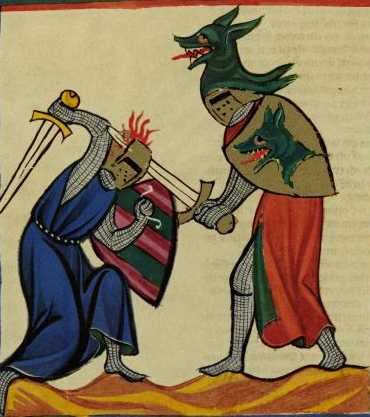
 Attachment: 99.16 KB Attachment: 99.16 KB
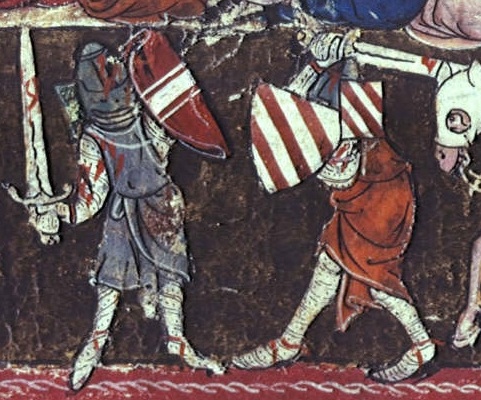
 Attachment: 20.09 KB Attachment: 20.09 KB
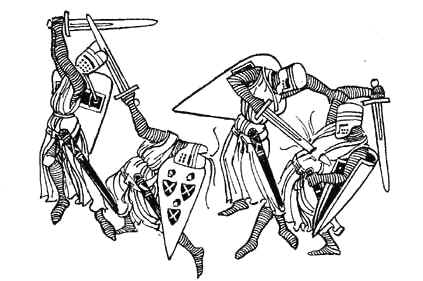
|
|
    |
 |
Stephen Hand

|
 Posted: Mon 29 Jan, 2007 1:24 am Post subject: Re: I.33 Weapon Question Posted: Mon 29 Jan, 2007 1:24 am Post subject: Re: I.33 Weapon Question |
 |
|
| M. Eversberg II wrote: | I am considering teaching myself I.33 fencing seince I've interest in the time period it was written in. I have generated the following questions:
1) What weapon are they using? As in, the Oakeshot Type? My guess is they where simple arming swords (Type XI?). |
When we wrote our book on I.33 Paul Wagner and I disagreed on which Oakeshott type the swords most resembled. Consequently in our book I use a type XII and Paul uses a type XVI. Within reason I don't think it matters too dreadfully much what sort of sword you use. Some very early swords have extremely short grips and pommels that restrict wrist movement so I'd avoid them and at the later end basket hilts protect the hand and change the dynamics somewhat. By the way, if you want to use our book Medieval Sword and Shield, I suggest that you also get a copy of Spada II. Spada is a periodic collection of papers on historical swordsmanship and Spada II contains a paper by me updating the interpretation found in Medieval Sword and Shield. All the books I've mentioned are available from Chivalry Bookshelf.
| Quote: | | 2) If I where a period man-at-arms, would I be using these techniques on the battlefield? Would I be using the buckler, or would I stick to the heater shield? (Heater in this case being as I know it, the typical Rounded V with a stright top, curved against your body) |
Bucklers were probably used on the battlefield. There are certainly depictions of them being used - notably an illumination from 1358 which shows one being used by a man-at-arms. I think it would be more common to see them being used as secondary weapons by foot soldiers - pikemen, archers and the like, but there aren't the number of images of such people. I think it would be much more usual for a man-at-arms to use a heater. Certainly images of heaters being used on the battlefield by men-at-arms abound. Any significant amount of armour -most notably arm harness, would affect the style of sword and buckler use quite dramatically, so I agree with Hugh that the sword and buckler system shown in I.33, while it may not be solely civilian is an unarmoured style.
| Quote: | | 3) Where there manuals for heater/arming sword? |
No, but there are a number of sword and shield sections in 15th and 16th century manuals, all of which are in broad agreement - regardless of the fact that they show massively different shields. Illustrations of earlier shields in use suggest that they were used in a broadly similar fashion to the documented style. I have written two papers on the evidence for how large shields were used. They were published in Spada and Spada II respectively. The only factor that dramatically changes how shields are depicted being used is curvature. Note how in the illustration of Sir Lancelot vs Mador (in Hugh's post) the chap on the left is holding his deeply curved shield with the face towards his opponent while the chap on the right is holding his flat or gently curved shield with the edge towards his opponent (incidentally I would be most interested in learning the origin of this image). This is all discussed in the two Spada papers. There is more to discover, but we have a very firm basis upon which to base any reconstruction of medieval sword and shield combat.
| Quote: | | 4) What would be a good waster for practice? I guess any one handed one would do, and you all have reccomended Little Raven (If I recall correctly) as the best source for these. |
I don't use wasters as they are potentially lethal but people seem to think they're safe. If I'm going to have to emphasise control then I prefer to use actual swords. I find that with control and respect, blunt replica swords are perfectly safe while without control and respect wasters aren't safe at all. In my experience people are far more likely to exercise control and respect when using real steel swords. Also, nothing behaves like a steel sword except a steel sword.
Cheers
Stephen
Stephen Hand
Editor, Spada, Spada II
Author of English Swordsmanship, Medieval Sword and Shield
Stoccata School of Defence
|
|
   |
 |
|
George Hill
Location: Atlanta Ga Joined: 16 May 2005
Posts: 614
|
 Posted: Mon 29 Jan, 2007 2:28 am Post subject: Posted: Mon 29 Jan, 2007 2:28 am Post subject: |
 |
|
Someone told me about a particular battle in which a commander placed a large number of sword and buckler troops behind his line of pikemen. The idea being that men armed in such a fashion would be able to flood into any gaps which were created, and give a good account of themselves whilst maintaining the overall integrity of the line. I have no information on what battle it was, or if this was at all a regular thing.
Further, in the old days Buckler and Target were used 'somewhat' interchangeably, so they may have been what we would call sword and target men. (The ancients were not as hung up on definitions as we are.)
To abandon your shield is the basest of crimes. - --Tacitus on Germania
|
|
    |
 |
|
Hugh Knight
|
 Posted: Mon 29 Jan, 2007 6:57 am Post subject: Re: I.33 Weapon Question Posted: Mon 29 Jan, 2007 6:57 am Post subject: Re: I.33 Weapon Question |
 |
|
| Stephen Hand wrote: | | No, but there are a number of sword and shield sections in 15th and 16th century manuals, all of which are in broad agreement - regardless of the fact that they show massively different shields. Illustrations of earlier shields in use suggest that they were used in a broadly similar fashion to the documented style. I have written two papers on the evidence for how large shields were used. They were published in Spada and Spada II respectively. The only factor that dramatically changes how shields are depicted being used is curvature. Note how in the illustration of Sir Lancelot vs Mador (in Hugh's post) the chap on the left is holding his deeply curved shield with the face towards his opponent while the chap on the right is holding his flat or gently curved shield with the edge towards his opponent (incidentally I would be most interested in learning the origin of this image). This is all discussed in the two Spada papers. There is more to discover, but we have a very firm basis upon which to base any reconstruction of medieval sword and shield combat. |
Hi Stephen,
You say that these later sources (Digrassi, Marozzo and others, I presume you mean) are all in broad agreement and that justifies using them to analyze armored sword & shield combat, and yet in your original post you admit that wearing an arm harness would significantly effect sword & buckler combat, thus implying a difference between armored and unarmored sword & buckler. Do you not believe that the fact that all extant sword & shield material is entirely unarmored would be therefore different from armored sword & shield?
Also, you say that "the only factor that dramatically changes how shields are depicted being used is curvature". Do you not agree that the use of the guige dramatically effects shield usage? I'll attach several pictures of S&S combat where the guige seems to play a large role.
I submit that more comprehensive armor lead to relying on the guige to support the shield since most of the body didn't really need to be "shielded" (pardon the pun) and that the shield then became much smaller and was used less actively--more for defending the face (which was often uncovered in serious life-or-death combat) and head (which was vulnerable to concussive impacts even when armored as seen by the fact that the head was a primary target even when early helmets were used). Note I said "less" active; it was still moved except when it was simply let to hang so both hands could be used on the sword (as in several of the examples I gave).
The Lancelot and Mador picture came from here:
http://www.imagesonline.bl.uk/britishlibrary/...artid=8031
Incidentally, there's an almost identical picture of the same scene from a different manuscript; I'll try to attach it below.
| Quote: | | I don't use wasters as they are potentially lethal but people seem to think they're safe. If I'm going to have to emphasise control then I prefer to use actual swords. I find that with control and respect, blunt replica swords are perfectly safe while without control and respect wasters aren't safe at all. In my experience people are far more likely to exercise control and respect when using real steel swords. Also, nothing behaves like a steel sword except a steel sword. |
While I agree with you about swords, I use wasters in my classes becuse of their cost. An arming sword waster costs about $60.00 USD, whereas even the cheapest steel arming sword that's worth using costs around $100.00 (and most really decent ones cost several times that). That means I can buy two wooden wasters for my students for little more than one steel replica. And when new students start buying gear wooden wasters allow them to get what they need more cheaply so they're not too financially committed when they aren't sure if this is what they want. More advanced students *must* have steel and/or aluminum replicas for various weapons, but for getting a bunch of people to start swinging swords wood is a better financial choice.
Regards,
Hugh
www.schlachtschule.org
 Attachment: 75.92 KB Attachment: 75.92 KB
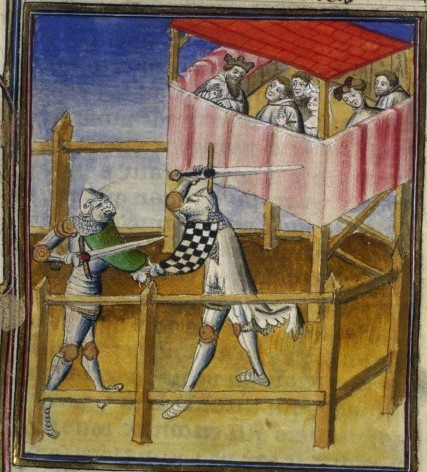
The Guige seems crucial here
 Attachment: 122.74 KB Attachment: 122.74 KB
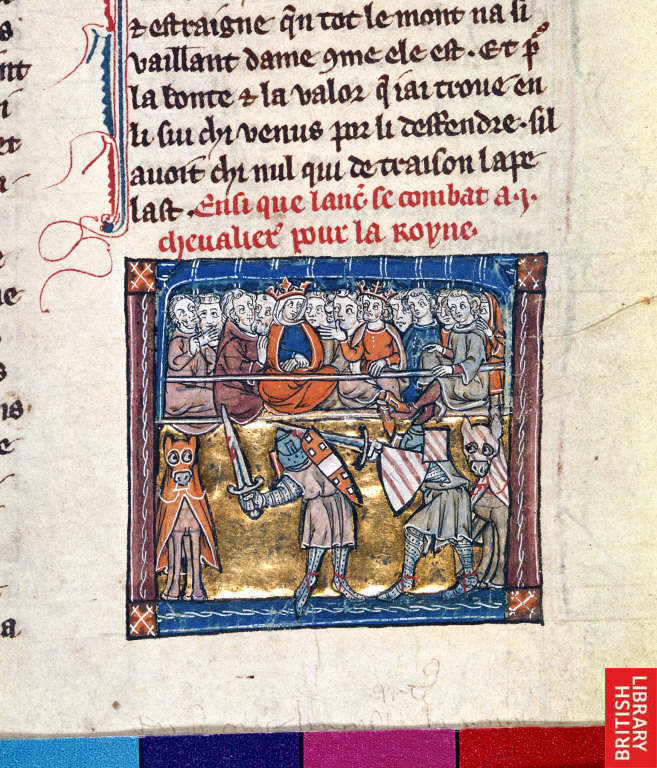
Similar to the Lancelot & Mador picture
 Attachment: 72.42 KB Attachment: 72.42 KB
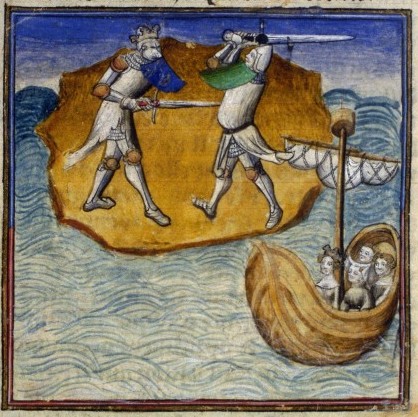
More guige play
 Attachment: 23.22 KB Attachment: 23.22 KB
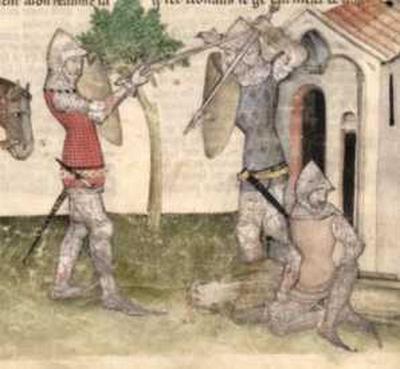
More Guige use
|
|
    |
 |
|
Lafayette C Curtis
|
 Posted: Mon 29 Jan, 2007 8:18 am Post subject: Posted: Mon 29 Jan, 2007 8:18 am Post subject: |
 |
|
| George Hill wrote: | Someone told me about a particular battle in which a commander placed a large number of sword and buckler troops behind his line of pikemen. The idea being that men armed in such a fashion would be able to flood into any gaps which were created, and give a good account of themselves whilst maintaining the overall integrity of the line. I have no information on what battle it was, or if this was at all a regular thing.
Further, in the old days Buckler and Target were used 'somewhat' interchangeably, so they may have been what we would call sword and target men. (The ancients were not as hung up on definitions as we are.) |
It was used interchangeably in the 19th-century translations. If we look back into the primary source material, it's clear that the men referred to in the passages were rodeleros equipped with rodelas--large round shields.
The battle you mentioned is probably the battle of Cerignola, where the Imperials used military engineering (field fortifications, that is) to break the formations of the Swiss pikes and the heavy horsemen in the French force so that their generally lighter force could fully utilize their better ability to fight in broken terrain. As far as I remember these tactics were not employed on open, unprepared battlefields, since all the accounts of it that I can remember off the top of my head are described in relation to field fortifications or natural rough terrain.
|
|
  |
 |
Elling Polden

|
 Posted: Mon 29 Jan, 2007 8:52 am Post subject: Posted: Mon 29 Jan, 2007 8:52 am Post subject: |
 |
|
Any sword from the time period (XII, XIIIb, XIV) will serve nicely for sword and buckler use. The XI belongs to a earlier period.
Unlike sword and buckler, sword and heather fighting never became a sport, and so we do not have any fighting manuals covering it.
As for the battlefield relevance of I.33 ,the basic principles (binds, shield strikes, and so on) still hold true with a heather.
The exact techniques, however, will in most cases be different.
It should also be noted that the battlefield is a quite different enviorment from the dueling ground.
On the battlefield, large numbers of opponents, polearms, and so on makes passive defence more important.
Also, even in a loose melee, you do not have the time to engage in lengthy duels; It's a good way to be chopped down from behind, and your friends need your help.
When it comes to the guiges, we have lately begun experimenting with guiges that allow you to hand the sheild in front of your body while wielding a polearm. These can be used actively by griping the front handstrap; However, without the rear strap in place, they are less suited for parrying high blows.
what they do is provide passive defence against enemy polearms and charging swordmen, as well as a opporunity for a quick covert from polarm to sword and shield.
"this [fight] looks curious, almost like a game. See, they are looking around them before they fall, to find a dry spot to fall on, or they are falling on their shields. Can you see blood on their cloths and weapons? No. This must be trickery."
-Reidar Sendeman, from King Sverre's Saga, 1201
|
|
    |
 |
Greg Coffman

|
 Posted: Mon 29 Jan, 2007 9:37 am Post subject: Posted: Mon 29 Jan, 2007 9:37 am Post subject: |
 |
|
In a period artwork study by the Association of Renaissance Martial Arts, several bucklers are pictured in depictions of battlefield combat as well as being worn by individuals armored too heavily to be less than men-at-arms. One of the points of the article is that bucklers actually appear more often in period art than other shields. The importance of the buckler among the fighting class should not be overlooked. The article may be found here:
http://www.thearma.org/essays/SwordandBucklerP2.htm
In the case of the sword and buckler as with other weapons, I would imagine that one must first learn how to use the weapon effectively in unarmored conditions to develop the control and coordination. This is not to say that unarmored combat equates to armored combat, but it seems silly to think of a professional fighter knowing his way around a buckler or any type of weapon while in armor but not knowing how to use that weapon out of armor.
Ms 1:33 represents one style of sword and buckler play in one area of Europe and during a specific time period. The combatants are depicted as monks who are not part of the fighting class unless they are a part of a military order. We don't know if that was the same way professional fighters would have employed the buckler or how exactly it would be used in battle. However it is one way and the earliest way we have in evidence of how the sword and buckler was used. It is also the only fighting system described in that time period. We have much more information from fight books from the 14th century and later.
If you want to learn how a fighter would have fought and with which weapons in the time period you are interested, I suggest finding period art such as the images already posted on this forum. While we can not be certain but must entertain levels of "likelihood," much may be extrapolated. Also, it is beneficial to learn the western martial arts that are available even though they might not be what you specifically are interested in. I would recommend learning sword and buckler from Ms 1:33 but also pursuing the longsword and sword and buckler combat extent in the German martial traditions which contains more material to study from than just Ms 1:33.
As far as waster, I personally recommend NSA for both product and service. I understand Raven Studios is popular, but I haven't personally dealt with them. Hollow earth produces wasters with the most aesthetic variety, however their customer service is extremely poor. If you go to a renaissance fair that they run a booth at you can handle several of their products and choose one that you prefer, but I do not recommend ordering from them. It is true that nothing handles or feels like steel but you can do pretty well with wasters (which were used historically by professional fighters as an acceptable simulator to steel).
For the word of God is living and active. Sharper than any double-edged sword, it penetrates even to dividing soul and spirit, joints and marrow; it judges the thoughts and attitudes of the heart.
-Hebrews 4:12
|
|
  |
 |
|
Eric Allen
|
 Posted: Mon 29 Jan, 2007 11:06 am Post subject: Posted: Mon 29 Jan, 2007 11:06 am Post subject: |
 |
|
On the Wood-vs-steel issue:
True, nothing feels quite like steel, and any serious practitioner should make extensive use of steel in their studies and practice,
BUT: for those of us who practice in public (by desire or necessity), swinging a steel sword--even a blunt one--can lead to unwanted attention and frantic calls from the neighbors to the police that "some wacko is out there waving a sword around!"
Using wood, however, tends to let you go about your business uninhibited.
And yes, wooden wasters can kill, and therefore control is very important (as it always is), but I would argue that the margin of error is slightly wider with wood.
As for the swords:
I echo what has been said before: pretty much any single-handed sword (within reason) should be just fine.
As for the waster:
New Stirling Arms is really good. The addition of metal weights into the hilt to more precisely mimic a "real sword's" balance and weight is a nice addition.
I've herd that Little Raven is good, too. Haven't come across any of their products, though.
Hollow Earth wasters are decent, but as has been said, buy them in person--not through the website.
Just my $.02
|
|
  |
 |
Stephen Hand

|
 Posted: Mon 29 Jan, 2007 4:53 pm Post subject: Re: I.33 Weapon Question Posted: Mon 29 Jan, 2007 4:53 pm Post subject: Re: I.33 Weapon Question |
 |
|
Hello Hugh,
Thank you for the source of that image.
| Hugh Knight wrote: | | Do you not believe that the fact that all extant sword & shield material is entirely unarmored would be therefore different from armored sword & shield? |
To a certain extent it must have been, as armour affects the way you move and your vulnerability, but it remains that surviving images of sword and shield combat (with the exception of those using deeply curved shields) show a remarkable consistency and conform to the principles laid down in the German and Italian manuals of the 15th and 16th centuries. So, a bit different, yes, certainly - dramatically different, it would appear not. The bottom line is that all available texts we have telling us how to fight with sword and shield are in broad agreement and pictorial evidence suggests that at least as a first approximation the same system was ubiquitous throughout the history of large shield use. If you are going to discard the historically documented system of shield use then what do you propose putting in it's place?
| Quote: | | Also, you say that "the only factor that dramatically changes how shields are depicted being used is curvature". Do you not agree that the use of the guige dramatically effects shield usage? |
I have fought with shields on guiges and it really doesn't make that much difference. I can do (and have done) all of the techniques shown in my Spada papers with a shield on a guige. The guige actually makes some techniques easier. Most of the shields you depict are deeply curved. Heavily curved shields are depicted in art being used less actively than flat or gently curved ones. I discuss this at length in Spada II, giving reasons and illustrating specific techniques. By less active I mean less offensively as contrary to modern common sense large shields were not moved to defend against attacks. This latter point is probably the central finding of my research into historical shield use.
Certainly experimentation with guiges is likely to reveal subtleties of which we were unaware, but I am confident that all competent historical sword and shield combat was based on the same basic principles as shown in the German and Italian manuals. Throwing out our only solid historical sources is most definitely not the way to go.
Cheers
Stephen
Stephen Hand
Editor, Spada, Spada II
Author of English Swordsmanship, Medieval Sword and Shield
Stoccata School of Defence
|
|
   |
 |
M. Eversberg II

|
 Posted: Mon 29 Jan, 2007 8:55 pm Post subject: Posted: Mon 29 Jan, 2007 8:55 pm Post subject: |
 |
|
Greg Coffman: I've also done a bit of reading into/light practice of the Litchenauer (spelling!) style of Longsword combat, from an article we have here in our Features, called "The German Longsword." It's very interesting and I rather enjoy it (thouhg all the other remotly interested people here *refuse* to learn a style, as they consider it dumb or "below them". One day someone is going to get hurt...)
To others: I *would* look at period art, but beyond tombstones, I personally consider looking at art to learn about real historical things in the middle ages would be a bit like our great great great great great great great great great grandchildren watching movies to learn about how WE did _____________. It's medieval hollywood for all I know...
M.
|
|
      |
 |
|
Jonathan Harton
|
 Posted: Mon 29 Jan, 2007 11:42 pm Post subject: Posted: Mon 29 Jan, 2007 11:42 pm Post subject: |
 |
|
So you are saying that we should just overlook one of the largest sections of potential supplementation to our knowledge base because it might be somewhat inaccurate to reality? Excuse me for being blunt, but that's insane!
I grant you that some artistic renderings of the period might be a little difficult to interpret because of the level of 3D depth and shading placement because of the style used during the middle ages, but that is hardly reason to discredit the entire plethora of combat art for the Medieval period. In the study of historical culture, you cannot just pick and choose what you like. Sadly many academics, including myself at times, fall into this for a number of reasons.
The best method is to look at whatever it is you have available and put it all together to make the previously unknown more clear. New findings will inevitably add new pieces to the puzzle over time and require reinterpretation and alterations in our comprehension, but you cannot just write off such a huge part of our understanding of Medieval culture.
Much of what we know about Medieval fashion, advancements in weapons and armour technologies, and religion stem directly from interpreting artistic renderings created in the period. Your argument could easily be used to say that because we don't have physical evidence of dozens of medieval garments outside of art that their is no proof to their actual existence despite the fact that artists represented them over and over again. The medieval artist did not generally operate from the same bias toward abstract art that many modern artist in all realms of creation do today. That was largely a post renaissance development in the Western world. Artist more often took great pains to render reality down to minute details. Why would this be any different for the representations of combat systems.
Take into account that most art was created by monastics for the majority of the Middle Ages. These men were the intellectuals of there era and likely not easily taken to misrepresentation of something so fundamental to medieval society as systems of combat. Many of these men lived in close contact with warriors, were warriors themselves, or were retired warriors who took vows late in life as a means to secure a good place in the afterlife. These were not men ignorant of what they were representing.
Being that we have no other hard evidence as to how sword and shield were employed during the High Middle Ages than art, what would you suggest? Even the M.S. I.33 itself is an artistic representation of combat. What makes it more or less valid than any other representation of the period? We trust it because we trust that people who actually lived in that time knew a little bit more than we do about the basics of how life in the era worked. Plus, when one actually does attempt to recreate many of they artistic combat interpretations of the period, it is often found that the feel natural and comfortable.
Don't waste historical resources, especially in a situation where they are limited, if they can help you at all.
|
|
  |
 |
Stephen Hand

|
 Posted: Tue 30 Jan, 2007 2:30 am Post subject: Posted: Tue 30 Jan, 2007 2:30 am Post subject: |
 |
|
To add to what Jonathan said, period artwork isn't the only source we have. We have a number of manuals which discuss the use of large shields. As they're generally later than the period of widespread shield use we have to ask the question, was this system of shield use new in the 15th century or was it the way shields had always been used. To answer that question I've looked at period depictions of shield use and have found them to be remarkably consistent with the system shown in the 15th and 16th century manuals. This suggests (not proves because art isn't video) that the recorded system of sword use wasn't new when it was recorded, but was based on the way shields were used in earlier periods. I am not basing a system on period artwork, but using period artwork to see whether the historically recorded shield system can safely be extrapolated back to earlier periods when shield use was more widespread, but unfortunately fencing manuals were not.
Remember that thousands of people fight on a regular basis with sword and shield and that the alternative to date has been making it up as you go along.
Cheers
Stephen
Stephen Hand
Editor, Spada, Spada II
Author of English Swordsmanship, Medieval Sword and Shield
Stoccata School of Defence
|
|
   |
 |
Elling Polden

|
 Posted: Tue 30 Jan, 2007 5:35 am Post subject: Posted: Tue 30 Jan, 2007 5:35 am Post subject: |
 |
|
There are only so many ways to hold a sword and shield in a drawing, especially when the artist isn't all that great at perspectives.
Historical ilustrations are a bit like four colour WWII comics from the 50'. You might, with some luck identfy historical weapons and uniforms, but it is hardly a reliable source on the nature of WWII warfare.
Like their medevial counterparts, modern cartoonist know what soldiers LOOK like. This does not automatically mean that they know how they fight, and even if they have seen fights take place, that they will portray it accurately.
"this [fight] looks curious, almost like a game. See, they are looking around them before they fall, to find a dry spot to fall on, or they are falling on their shields. Can you see blood on their cloths and weapons? No. This must be trickery."
-Reidar Sendeman, from King Sverre's Saga, 1201
|
|
    |
 |
Stephen Hand

|
 Posted: Tue 30 Jan, 2007 4:38 pm Post subject: Posted: Tue 30 Jan, 2007 4:38 pm Post subject: |
 |
|
And if I was basing an interpretation of how medieval people fought with shields on artwork alone those would be valid comments...but I'm not. I am using medieval (and earlier) artwork to examine whether or not the system described in fencing manuals in the 15th and 16th centuries was likely to have been the way medieval people used shields. Almost exclusively I found stances and in some cases techniques identical to those shown in the manuals (and very different to the "common sense" stances and techniques used by re-enactors I've known or seen). Does this prove that shields were always used in an absolutely identical way - no, there are a lot of factors that produce subtle changes in shield use and the likelihood of shield use being completely unchanged over hundreds of years and many different shield shapes is not high. Does it strongly suggest that all shield combat was based on the set of principles which are present in the manuals, principles which are quite different to those worked out by re-enactors making it up as they went along? The answer to this must be a resounding yes!
Once you appreciate the underlying principles of big shield combat you can see them at work in illustrations all over the place and frankly it's hard to think that no one has come up those principles independently (maybe someone has, but I've not met them).
Cheers
Stephen
Stephen Hand
Editor, Spada, Spada II
Author of English Swordsmanship, Medieval Sword and Shield
Stoccata School of Defence
|
|
   |
 |
|
Lafayette C Curtis
|
 Posted: Wed 31 Jan, 2007 7:01 am Post subject: Posted: Wed 31 Jan, 2007 7:01 am Post subject: |
 |
|
|
Brian Hunt from ARMA claims to have figured out the same principles independently in a discussion we had not long ago. I really wish he were not so busy with his Paulus Hector Mair polearms project. That way he would have been able to publish about it and we non-ARMAteers would have had the luxury of comparing the similarities and differences between his intepretations and yours.
|
|
  |
 |
M. Eversberg II

|
 Posted: Sun 04 Feb, 2007 11:31 am Post subject: Posted: Sun 04 Feb, 2007 11:31 am Post subject: |
 |
|
Would metal "Stage Steel" series weapons from vendors such as Kult of Athena be sufficient for practice? I think Merc's Talor will be where I get my bucklers, unless someone has other suggestions.
M.
|
|
      |
 |
|
|
You cannot post new topics in this forum
You cannot reply to topics in this forum
You cannot edit your posts in this forum
You cannot delete your posts in this forum
You cannot vote in polls in this forum
You cannot attach files in this forum
You can download files in this forum
|
All contents © Copyright 2003-2024 myArmoury.com — All rights reserved
Discussion forums powered by phpBB © The phpBB Group
Switch to the Basic Low-bandwidth Version of the forum
|

